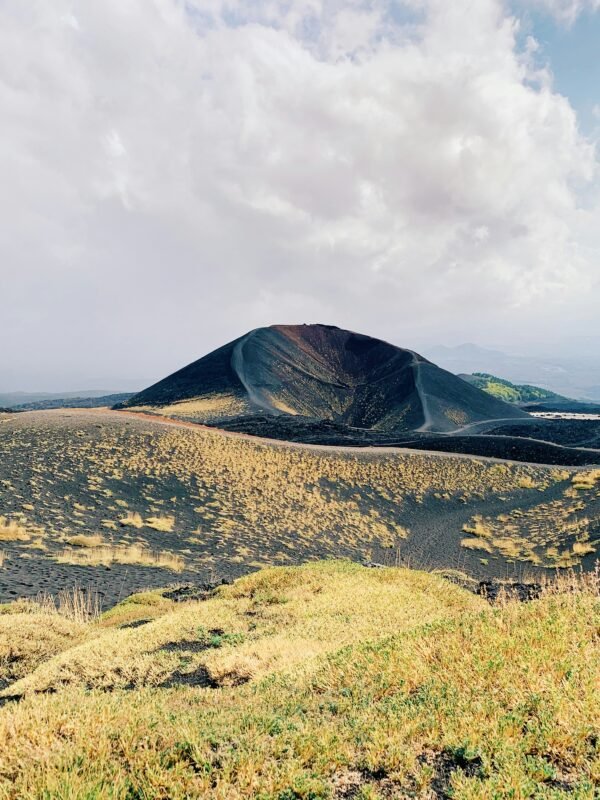Introduction
Mount Etna, also known as Mongibello, is a majestic stratovolcano located on the eastern coast of Sicily, Italy. This imposing volcano originated in the Quaternary period. It is the tallest active volcano on the Eurasian Plate, with its height varying due to frequent eruptions, generally exceeding 3,300 meters. The geological formation of Etna is complex. It is characterized by layers of lava, volcanic ash, and other pyroclastic materials accumulated over millennia.
Geological Formation of Etna

The eruptive history of Etna is long and fascinating. The first documented eruptions date back to 1500 BC. However, geological evidence indicates volcanic activity as early as 500,000 years ago. Eruptions can be effusive, with lava flows, or explosive, with ash and lapilli emissions. These create spectacular smoke columns visible from miles away. Significant eruptions include those in 1669, when a lava flow destroyed part of the city of Catania, and in 1992, which threatened the town of Zafferana Etnea.
Scientific Importance
From a scientific perspective, Etna is a treasure trove of information. Notably, volcanologists and geologists consider it a natural laboratory, studying magmatic processes and volcanic eruption dynamics. Consequently, this scientific interest translates into constant monitoring of volcanic activity. Specifically, networks of seismographs, GPS, and other advanced technologies allow for the prediction and management of eruption-related risks.
Major Craters of Etna
Major Craters of EtnaThe main craters of Etna include the Northeast Crater, the Southeast Crater, and the Bocca Nuova. Each of these contributes to the volcanic activity of the complex. Recent activity at Etna has seen frequent Strombolian and paroxysmal eruptions. While spectacular, these represent a constant threat to local communities. Nevertheless, Etna continues to be one of Sicily’s main tourist attractions. It fascinates visitors from all over the world with its imposing presence and perpetual activity.

Cultural and Historical Importance of Etna
Mythology and Legends
Etna, the largest active volcano in Europe, has always played a central role in the culture and history of Sicily. Indeed, its majesty and volcanic activity have inspired myths and legends. For instance, in Greek mythology, Etna was considered the forge of the god Hephaestus, the blacksmith of the gods. Furthermore, in Roman mythology, it was known as the home of the giant Enceladus, buried under the mountain after a battle with the gods. Consequently, these tales evoke the volcano’s power and highlight its symbolic importance as a place of transformation and power.
Etna in Literary and Artistic Works
Etna has also found a prominent place in literary and artistic works. Poets like Pindar and Virgil described Etna in epic tones. Painters and sculptors have captured its majesty and terror countless times. The mountain was a favorite subject for Grand Tour travelers, who documented its beauty and danger in their journals and drawings. In this way, Etna has helped shape the collective imagination not only of Sicily but also of the entire world.
Influence on Daily Life
Etna’s influence extends to the daily lives of ancient populations that settled on its slopes. Greeks and Romans founded numerous towns and settlements at the foot of the volcano. Among these, Catania became an important commercial and cultural center. The presence of the volcano impacted economic life. The volcanic soils are fertile and ideal for agriculture. It also influenced social and religious life, with rituals and ceremonies dedicated to volcanic deities.
Ingenious Adaptations
Ancient inhabitants of the region developed ingenious techniques to live with the eruptions. They built lava channels and shelters. These adaptations testify to the resilience of the populations. They also underscore Etna’s crucial role in their environment and cultural identity. Today, Etna continues to be a living symbol of Sicily, uniting past and present in a fascinating blend of history, culture, and nature.
Etna in the Middle Ages and the Renaissance
Medieval Imaginary
During the Middle Ages and the Renaissance, Mount Etna maintained a significant role in the culture and history of Sicily. Numerous chronicles and historical accounts from this period testify to the volcano’s influence on daily life and popular beliefs. In the medieval imagination, Etna was often seen as a manifestation of divine power. It was a place of mystery and reverential fear. Volcanic eruptions were interpreted as signs of divine will. Narrators and chroniclers of the time often reported these events with apocalyptic tones.
Renaissance: Scientific Vision
During the Renaissance, interest in the volcano extended to artistic and literary representations. Renaissance artists and poets were fascinated by Etna. It became a symbol of natural strength and wild beauty. Works from this period reflect a more scientific and less superstitious view of the volcano. The sense of wonder and respect for its majesty remained intact. Painters and sculptors often depicted Mount Etna in their works, using it as a dramatic backdrop for mythological and religious scenes.
UNESCO Heritage and Etna Today
UNESCO Recognition
In 2013, Etna was officially recognized as a UNESCO World Heritage Site. This title highlights the global importance of this active volcano. The recognition process was complex. It required demonstrating its universal value, both from a natural and cultural perspective. This recognition marked a significant step toward the conservation and protection of the area. Targeted efforts preserve Etna’s ecological and geological integrity.
Cultural Value
The UNESCO recognition amplified the site’s universal value. It emphasized the volcano’s importance not only as a natural phenomenon but also as a cultural symbol. Etna is deeply rooted in Sicilian traditions and popular culture. Festivals and celebrations related to the volcano, such as the Feast of Saint Agatha, are emblematic examples. Additionally, the region’s agricultural and artisanal traditions are closely connected to the fertile volcanic soil. This has favored the growth of vineyards and other typical crops.
Tourist Attraction

Today, Etna is one of Sicily’s main tourist attractions. It attracts thousands of visitors every year. Excursions to the craters, visits to alpine shelters, and tastings of local products offer a unique experience. This combines nature, culture, and gastronomy. Additionally, the volcano inspires numerous contemporary cultural and artistic projects. From films to music festivals, these events celebrate the volcano’s beauty and historical importance.
Traditions and Popular Culture
Festivals and Celebrations
The traditions and popular culture related to Etna are numerous and varied. They reflect the deep connection between the volcano and the region’s inhabitants. Religious festivals, such as the Feast of Saint Agatha in Catania, are among the most important celebrations in honor of the volcano. This festival attracts thousands of faithful and tourists.
Agriculture and Artisan Traditions
The region’s agricultural tradition is closely linked to Etna’s volcanic soil. The vineyards growing on its slopes produce some of Sicily’s finest wines, such as Etna Rosso and Etna Bianco. These wines are renowned for their unique taste, influenced by the minerals present in the volcanic soil. Other agricultural products, such as citrus fruits and olives, also benefit from the fertile volcanic lands. Agriculture is a vital part of the local economy.
Conclusion
Etna is much more than just a volcano. It is a symbol of natural power, cultural resilience, and wild beauty. Its imposing presence has influenced Sicily’s history, culture, and economy for millennia. It has left an indelible mark on the island’s identity. Recognized as a UNESCO World Heritage Site, Etna continues to fascinate and inspire. It unites past and present in a captivating blend of history, culture, and nature. Looking to the future, Etna remains a beacon of discovery and wonder. It is an eternal symbol of Sicily’s strength and beauty.
Share your photo and get featured on our social media.
Upload now and shine with The Glanz!